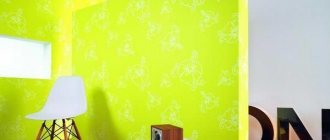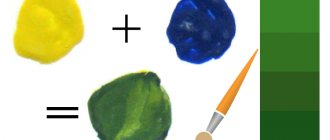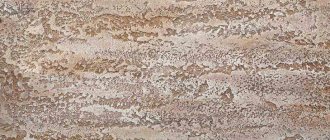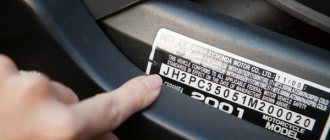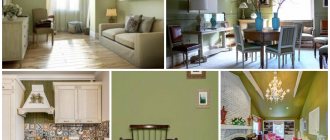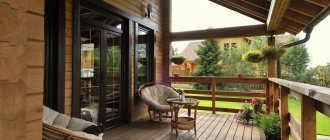Designers devote a large amount of time to the color scheme in the interior of a room. Using combinations of shades creates a beautiful design, but if you make a mistake, you can get the opposite effect. If you want to get original colors on the surface, you can choose a pearlescent color. More details about the features of using pearl tones will be discussed below.
Description and characteristics
This is a simple diagram of what nacre looks like on a microscopic scale.
Mother of pearl consists of hexagonal plates of aragonite (crystals of calcium carbonate CaCO3) measuring 10-20 microns wide and 0.5 microns thick, arranged in parallel layers. These layers are separated by sheets of organic matrix composed of elastic biopolymers (such as chitin, lustrin and silk-like proteins).
Light passing along the axis of one of the crystals is reflected and refracted by other crystals, creating a rainbow effect. This can also be explained by the fact that the thickness of aragonite crystals is comparable to the wavelength of visible light and therefore light of different wavelengths experiences numerous and varied interference, resulting in different colors depending on the viewing angle.
Rainbow Nautilus Mother of Pearl
Mother-of-pearl is softer in structure and is much easier to find in nature than pearls. But their differences do not end there - unlike pearls, nacre does not come in a round shape.
The mineral has the following physical properties:
- hardness on the Mohs scale - 2.5-4 units;
- density - 2.7 g/cm3;
- luster - glassy;
- transparency - opaque.
Mother-of-pearl is created by sea and river mollusks, and sea mollusks are more valuable, as they come in different shades.
River mother-of-pearl is only white.
How to make a smooth transition when painting with three-layer paint?
- For a smooth transition of three-layer mother-of-pearl, more space is required than when painting with conventional colors. First you need to make a smooth transition of the base, then the transition of the mother-of-pearl. It is better to use the reverse transition technique.
In a reverse transition, the first layer is applied from the furthest area up to and including the repair area, forming the main edge of the transition. Subsequent layers are applied inside the previous ones, at a distance of 8–10 cm.
- What is a reverse transition? The usual, direct transition is made from the repair area, towards the adjacent area (where the original paintwork is). One of the limitations of this method is that each subsequent layer rests on dry dust from the previous layer. The transition is noticeable when painting “complex” colors. This problem can be solved by applying an intermediate layer of basecoat blender (transition agent/clear base). We will look at this point a little later. The reverse transition technique is used when painting with metallics and pearls, where the location of the particles that give the effect of the paint is important. Using this method, the painter first applies the first coat, starting from the furthest area (30–45 cm from the repair area to the adjacent area) and continuing up to and including the repair area. The second layer is applied inside the first (about 10–12 cm closer). Each subsequent layer is smaller in area than the previous one. Each subsequent layer is applied on top of a smooth previous layer (not dry dust), the particles in the new paint are located as they should.
- The paint is applied with 75% overlap of the passes and smoothly pressing the trigger at the beginning, releasing the spray gun trigger at the end of the pass (while the movement of the spray gun continues). Overlapping the spray gun passes by 75% reduces the likelihood of streaks appearing on metallics and pearls, and ensures a uniform paint film and smooth texture.
- So, to paint a three-coat fade, start by applying the base to the primed area, extending each coat slightly onto the adjacent area, creating a fade. Typically 2-4 coats are required to cover the repair area. When transitioning smoothly, the base should not be applied in thick (wet) or dry layers. Dry each layer for 5-10 minutes.
- After covering the base with soil, you need to increase the transparency of the base by 2 times. This can be done by adding basecoat blender (essentially a transparent base/binder diluted for spraying) or mixing with pearl diluted for spraying (in a 1:1 ratio). Applying a translucent base will be a transition layer for a smooth transition from a regular base to mother-of-pearl. Reduce air pressure and make a smooth transition to the adjacent area. Spray 1-2 thin coats. Use the reverse transition technique. Each layer is applied at a distance from the previous one (approximately 10 cm). Observe drying between layers. Before spraying the mother-of-pearl, the transition along the base should be invisible, otherwise the mother-of-pearl will not hide the visible edge of the base.
- When the base has dried, wipe the surface with a gauze pad to remove excess dust. Use special gauze pads for the base. They are slightly sticky, unlike regular ones. Read more about antistatic wipes and their proper use in another article.
- Next, the mother of pearl is applied using the reverse transition method. Before applying it, you need to shake it well and mix it so that all the particles are evenly distributed. Use the same spray gun pressure and paint flow as you would when applying to the test plate. Apply the mother-of-pearl from a distance of 20–25 cm. You should try to limit the transition area of the mother-of-pearl a little further than the edge where the transition of the base (translucent, as described above) ends. It is important that you do not spray multiple layers of pearl over this area and end up with an oversaturated edge that will look like a different shade. Apply the second layer using the same method, remaining inside the first layer (stepping back approximately 10 cm from its edge and spraying up to and including the repair area), the third layer is applied with the same indentation inside the 2nd layer. You can mark on masking tape where the approximate edge of the sprayed layer is to make it easier to navigate. Thus, there will be no formation of a saturated layer of nacre in one place. All transition edges should be smooth.
- After drying the applied layers, the painted surface is varnished. The varnish is applied completely to the entire surface prepared for painting.
- You can also mention an additional layer of basecoat blender, which can be applied after covering the repair area with the basecoat. This is usually a transparent diluted base (binder). It is diluted in the same way as any base (1 part binder with 1 part diluent, preferably a slower one). The idea is to fill small scratches and form an even, smooth surface so that during a smooth transition of nacre, the particles are positioned correctly and do not get into small scratches and create visible defects. In water-soluble paints, this stage is very important. When painting with regular paint (not water-soluble), you can do without this layer, but it makes it easier to create a smooth transition. The wet coat combats issues such as visible fade lines and misalignment of metallic or pearlescent particles. It also provides improved wetting of the transition edge, the paint will not lie dry in the newly applied transparent layer, and minor scratches in the transition area are eliminated. Basecoat blender (diluted binder) is applied to the area around the repair area (almost the entire area of the panel). Use a closer distance when applying (approximately 10 cm from the surface), moving the spray gun quickly. Minimum drying time after application is required, 1-2 minutes. Since in the above instructions, after covering the soil with the base, there is an intermediate layer of translucent base, it partially performs the function of a basecoat blender layer (a completely transparent base diluted for spraying). However, the translucent base is not sprayed onto the entire surrounding area, therefore, if desired, you can additionally apply a layer of basecoat blender (transparent base) before applying the translucent base.
Historical reference
Mother-of-pearl inlay is found in Egyptian pyramids; a seven-thousand-year-old necklace made of this mineral, made by Mesopotamian craftsmen, was found in modern Iraq.
In the East, the favorite was the white variety of stone.
Alavaster inlaid with mother of pearl
It was believed that mother of pearl is a mineral of such power that it can easily teach the owner to recognize people’s thoughts. No wonder the eccentric Roman dictator Nero ordered the walls of his residence to be covered with iridescent plates.
Aesculapians of the ancient world used the powder as an antiseptic for wounds. This was its main meaning for a person of that time, when countries were constantly at war with each other.
Medieval healers made pearl dust the basis of tinctures and potions. The mineral was used to decorate temple interiors and utensils. However, the stone played a cruel joke on many clergy in Europe. Having come up with the idea of selling weightless particles scraped from shells as “angel feathers,” they quickly became rich. After which they renounced their rank, becoming laymen.
A curiosity from the East captivated the Russian and European nobility at the turn of the 17th-18th centuries. Iridescent tabletops of dressing tables, snuff boxes, and boxes decorated boudoirs and offices.
Maria Stuart assembled a complete set of mineral accessories. The Hermitage keeps the mother-of-pearl collection of the Russian empress Catherine the Great, hundreds of copies.
Many people identify mother-of-pearl with pearls. But pearls appear when a foreign object gets inside the pearl shell. If nothing penetrates the valves, the secretion produced by the mollusk grows on the walls of its shell. This forms an iridescent iridescent layer several millimeters thick. It's called mother of pearl.
Production
The main places where mother-of-pearl shells are mined are the Persian Gulf, the Red Sea, Ceylon, Japan, Borneo and the Philippines, and some tropical islands of the Pacific Ocean. Often these shells are a by-product of cultured pearl production.
Inner mother-of-pearl layer of the pearl barley shell
Mother of pearl is also extracted from some freshwater mollusks, in particular pearl barley.
Before the use of synthetic pigments and polymers to imitate mother-of-pearl, from the middle of the 17th century, “pearl essence” (a suspension of silver pigment washed from the scales of some fish, in particular bleak, in gelatin) was widely used, which was used as a mother-of-pearl pigment for paints, for the production of artificial mother-of-pearl and pearls.
Artificial pearlescent pigments are made from microscopic particles of certain varieties of mica, glass with translucent layers of metal oxides deposited on the surface of the particles, and fine metal powders in polymers.
Design ideas
There are many ideas for pearl manicure. In the new season, minimalism and naturalness are a priority. The popularity of French and combinations of matte shades with pearlescent ones is increasing. For an evening celebration, nails can be decorated with velvet painting, stucco, rhinestones, beads, beads, bouillons, and stickers. Moon manicure, gradient, geometric patterns and plain pearlescent shades are also still on trend.
It is important not to overdo it with the design, so as not to make the image heavy and tasteless.
Manicure with pearl rub
This manicure technique allows you to make your nails soft and graceful. The shine of mother-of-pearl and delicate tones emphasize the individuality and romance of the image. An unusual pearl shine is suitable for everyday manicure. Rubbing helps to achieve the effect of glow and shine on your nails.
Mother-of-pearl manicure with drawings
Designs on pearl nails can be varied. Complex artistic painting and ornament will look attractive. Minimalism is also relevant: geometric patterns, flowers, abstraction. The choice depends on your desire and mood, do not be afraid to experiment.
Mother of pearl jacket
Pearl French manicure is one of the most popular types of French manicure, which many representatives of the fair sex choose for a wedding celebration. This design is also suitable for corporate events, birthdays and other holidays.
The beauty of a mother-of-pearl jacket does not depend on the shape and length of the nails; in any case, it will look gentle, stylish and attractive.
Pearlescent manicure with holes
Another current option is a lunar jacket in delicate pearlescent tones. The nail holes can be made transparent or bright to create a contrast with the base color.
Pearl manicure with rhinestones
A shining mother-of-pearl manicure is ideal for a special occasion - prom, wedding, romantic dinner. Rhinestones and stones perfectly complement the pearl shade, giving it individuality and irresistibility.
Pearl manicure with sparkles
The shiny mother-of-pearl design can be complemented with sparkles and glitter.
The following techniques are suitable for this:
- coating with shimmering effect;
- mirror coating;
- pearlescent pigment;
- unicorn rub;
- applying glitter.
Color varieties
Like pearls, nacre can be either river or sea. However, this feature does not significantly affect the appearance of the stone. The properties of the water and the oyster itself are more important.
Electron microscopy
Mother of pearl has a layered structure, and each layer may differ from the previous one. Due to this, a specific shell color is formed. The stone itself has many shimmers and complex shades. Colors may vary depending on lighting.
The following shell colors are more common:
- white;
- gray;
- silver;
- cream;
- pinkish;
- golden;
- copper;
- brownish;
- olive;
- black.
White mother-of-pearl is the most common type. Oysters that produce this pigment are the most common.
Rare and expensive varieties of stone include dark gems. More often, a similar color can be seen in marine representatives. Such minerals are distinguished by a richness of shades. In the light, dark colors glow green, purple and blue.
Three-layer paint on new body panels
When replacing a body panel, transferring paint to adjacent panels is a necessity to ensure that the transition of new paint to old is unnoticeable.
Optionally, you can first cover the adjacent panel with masking material, onto which a smooth transition will then be sprayed. It closes during base application to give the replacement panel a base color. When applying the base, dust and part of the paint will not fly onto the adjacent part. Next, all that remains is to remove the camouflage material and make a smooth transition.
A new body panel should be painted, making a smooth transition to the adjacent panel (or panels) so that there is no difference in color.
- Apply the base to the new part until covered (usually 2-3 layers). Apply medium-wet coats. Dry between layers for 3-5 minutes at a temperature of 20 degrees.
- Add 1 part diluted clear base/binder or pearl to 1 part diluted base and apply 1-2 coats to the adjacent area, blending smoothly. Apply layers using the reverse transition method (first the transition itself is formed, then the paint is sprayed inward, towards the part to be painted). Let dry for 5-10 minutes. Wipe the surface with a special, slightly sticky cloth to remove pollen.
A base (substrate) is first applied to a new panel with a smooth transition to the adjacent panel.
- Apply mother-of-pearl using the reverse transition method, from the outside to the inside. First, apply a layer from the farthest area, creating a transition zone (a little further than the edge of the base transition), then the entire part is covered with mother-of-pearl. Each next layer goes inside the previous one. Interlayer drying is 3–5 minutes at 20 degrees Celsius. When applying pearl, use the same distance, air pressure, and number of coats as when spraying the test plate. Avoid spraying too wet or too dry.
Mother of pearl is applied using the reverse transition method. The first layer is applied from the farthest point, forming a smooth transition edge, up to and including the painted panel. The next layers are applied inside the first, with an indentation of about 10 cm.
- Before varnishing, let the applied mother-of-pearl dry for 20–30 minutes. Next, apply varnish to the entire surface.
All parts prepared for painting are completely coated with varnish.
The magical properties of mother of pearl
Saucer made of mother-of-pearl
The magical qualities of mother-of-pearl are similar to pearls, but are less pronounced. People believed that the stone endowed the owner with health, luck, beauty, and wisdom. The mineral protects the home from evil spirits and prolongs the life of the owner. Mother-of-pearl jewelry makes the owner irresistible.
It has been established that the magical properties of colored mother-of-pearl vary:
- White. The gem is needed by everyone who is overcome by anxiety, stress, and self-doubt. It will attract pleasant novelty, joy and useful allies.
- Pink. The embodiment of romantic feelings. A large curlicue shell in a prominent place will save the family hearth, attract money, and give peace of mind to household members. The easiest way to convey tender feelings is by giving a pink-pearl item. Will protect you from troubles on the road.
- Coffee cinnamon. A business attribute, suitable for workaholics or careerists. The stone will ensure the favor of management, productive work, and eliminate conflicts in the team.
- Black. The properties of this mother of pearl are valued by the occult community. If the owner manages to establish contact, the stone will make him a magician. It is said that the water in the black mineral cup becomes the elixir of life.
Box inlaid with mother-of-pearl. Museum exhibit
Mother-of-pearl shells are amulets for sailors and travelers. In general, the use of this stone as an amulet protects against negativity, both physical and mental. The stone is especially useful for children against the evil eye.
Talismans and amulets are made from mother-of-pearl alone very rarely. More often it is combined with pearls, opal, amethyst, and turquoise. It is believed that this combination enhances the energy of the mineral.
An energetically friendly gem turns the owner into an optimist, striving to conquer new heights. However, prolonged “captivity” in a case or box weakens the magical properties of the stone and it becomes dull.
Important!
Frequently wearing jewelry with mother-of-pearl is beneficial for both the stone and the owner.
Medicinal properties
The use of mother-of-pearl in the treatment of diseases is only an additional remedy to the treatment prescribed by the doctor.
People have been studying the healing properties of mother-of-pearl for centuries. Today it has been established that it has a complex effect on the body:
- strengthens the immune system;
- promotes rapid recovery of an organism exhausted by disease;
- cleanses blood vessels;
- calms the nerves.
It is advisable to wear jewelry closer to the problem area of the body.
Types of mother-of-pearl jewelry and diseases for which they will be useful:
- hairpin or tiara - migraine, headache;
- pendant, beads or brooch - cardiovascular problems;
- light earrings - hearing impairment, ear diseases.
Black mother of pearl helps with diseases of the skeletal system and respiratory organs.
Various tinctures and ointments are made from pearlescent powder. They are used for inflammation of the joints and skin diseases.
This mineral is used to make cosmetics: serums, creams, emulsions, masks, tonics. All this helps improve skin tone and whiten age spots.
In some eastern countries they drink water infused with mother-of-pearl. It is believed that it has a general strengthening, tonic effect.
Three-layer paint “white pearl”
White paint, when pearl particles are added to it, hides the effects that these particles give. What happens when you add pearl to white is that it looks "dirty" and the effects of sparkle, depth and color change don't show up. So, in order for the white to remain bright and to add pearlescent effects to it, the paint is applied in the form of a three-layer coating. The pearlescent pigment is added to a clear binder and applied as a separate layer to the pre-sprayed white base coat. The shade of the white base layer changes slightly and acquires a pearlescent sheen. Next, a varnish is applied to protect the paint.
To match the color of a three-layer paint, both the base color and the number of layers of pearl must match. The middle layer affects the accuracy of the color match. The more layers of mother-of-pearl are applied, the darker the shade becomes, and the pearlescent effect also changes.
When applying the mother-of-pearl layer, use test plates to check the number of layers of mother-of-pearl. We will look at how to make them at the end of this article.
Areas of application
Many people think that mother-of-pearl jewelry is the only possible outcome for the inner layer of shells. But this is just the tip of the iceberg.
Modern box inlaid with mother of pearl
The stone gained such popularity that they began to make everything possible from it. Moreover, this trend did not appear today - the inner layer of a mollusk shell has been used by humanity for a very long time. The magical properties of mother-of-pearl contributed a lot to this.
It is used to make:
- church utensils (for example, for the covers of holy books);
- household items;
- jewelry boxes (Muslims used to store the Koran in similar boxes);
- special spoons for tasting caviar (a layer of mother-of-pearl protects caviar from contact with metal, preventing it from affecting its taste) and other serving items;
- musical instruments (they decorate guitars, violins, piano keys and saxophone buttons);
- ceramic tiles;
- all kinds of accessories (fans);
- weapons (they do not make it from mother-of-pearl itself, but use the stone for decoration).
This is interesting!
The stone is actively added to cosmetics. Such creams whiten the skin, eliminate age spots, and make freckles almost invisible.
Advantages and disadvantages of pearl manicure
A beautiful mother-of-pearl manicure is a win-win option for romantic evenings, weddings, and work corporate events. Also, such nails will harmoniously complement any everyday female look.
Nail artists can control shine and change brightness using modern materials and techniques. Nude shades are distinguished by functionality, originality, attractive appearance, long-term wear without defects or deformation.
The disadvantage of this design is the visibility of any imperfections on the fingers: if there are cracks or irregularities on the nail plate, the pearl design will only emphasize their presence. Also, the cuticle should be in perfect condition without cuts or burrs.
The master can eliminate all these imperfections with medical procedures, polishing, careful trimming, and leveling with the help of special bases and products.
Jewelry
Mother of pearl bracelet
Products and jewelry with minerals occupy the middle price segment. Mother-of-pearl plates look best in a white or grayish frame (silver, gold or platinum).
The mineral is combined with gems similar in nature and qualities:
- coral;
- pearls;
- turquoise;
- malachite.
Upon request, they can create mother-of-pearl jewelry with high-class precious stones.
Examples of interiors in pearlescent tones
Mosaic panels and frames are examples of adding pearls to the interior. Kitchen aprons are created from mosaics with a glow, silk-type textiles are placed. And of course the walls, floors and ceilings are finished. Lamps, floor lamps and decor will find application in any room.
Mosaic panels and frames are examples of adding pearls to the interior.
Mother-of-pearl decoration has been used since ancient times; it helps to calm down and add elegance to the interior without the effect of oversaturation. There are many options for adding pearl color; the option for a minimalist style is more suitable.
How to recognize a fake
This is interesting!
Interesting fact: counterfeiting of gems began three hundred years ago. In those days, fish scales were used to create the mineral. Its shiny particles were mixed with molten glass.
Faceted mother of pearl beads
Nowadays, plastic, glass, and various polymers are used to produce imitation.
To distinguish natural mother-of-pearl from artificial one, you need to know several techniques:
- If you poke a mineral with a needle, it will remain unchanged. There will be marks or chips on the plastic.
- Natural stone has a porous texture that is clearly visible when magnified.
- Genuine minerals are much heavier than plastic fakes.
- Mother of pearl has low thermal conductivity, so it slowly heats up from air or body temperature.
New technologies make it possible to create an imitation that is difficult to distinguish from real stone. Therefore, before purchasing jewelry, you should carefully study not only the type of mineral, but also the documentation provided by the seller.
How to distinguish a fake from a real stone
Natural stone is often faked. As an imitation, plastic products or stones from the fruits of the bone palm, which grows in Peru, are used.
To distinguish a real gem from a fake, you should pay attention to the following features:
- Structure. To assess the authenticity of a crystal, you should rub it on your lip or examine the structure under a microscope. Natural stone must be porous. Its structure necessarily includes grooves and irregularities. The imitation will have a perfect surface.
- Strength. If you try to scratch a real mineral with a nail or needle, it will not be damaged. In this case, marks will certainly remain on the plastic.
- Thickness. The layer of mother-of-pearl does not exceed 2 mm. Larger fragments of the mineral are used to create elite products. If they are sold in a regular store, this most likely indicates a fake.
- Temperature. When exposed to fire, mother-of-pearl loses its hue, becomes cracked, or becomes dull.
Beads, earrings or inlay plates are often made from pressed mother-of-pearl. Since the product has a natural base, it is not classified as a fake.
The natural mineral is considered quite durable, but it gets dirty quickly and needs to be treated with care. To preserve its properties for a long time, you need to do the following:
- Clean the gem with a soft cloth, moistening it in potato juice.
- To restore shine, you need to immerse the product in a warm soapy solution. The gem must be rubbed with a soft brush or cotton wool, covered with damp potato starch, and then rinsed.
- The mineral must not be dropped. It also tolerates temperature fluctuations and prolonged exposure to ultraviolet radiation.
- Natural stones develop cracks and become more cloudy when exposed to water, chemicals and cosmetics.
- To make the gem more durable, it must be immersed in a saline solution.
It is better to remove jewelry with mother-of-pearl before a long summer walk or going to the beach. They should be put on after applying makeup.
Artificial mother of pearl
For the first time, the mineral was recreated artificially by scientists at the University of Cambridge in 2012. Biopolymers were deposited on glass in a thin layer. The substrate was then placed in a new solution of polymers with mineral salts identical to the components of seawater. The solution was changed until a pearl similar to natural pearl was obtained.
In China, scientists have developed their own method for creating an artificial mineral. The Chinese formed crystals by freezing. The layered structure was obtained by cooling dissolved chitosan. When vinegar was added, a fine-grained substance was formed that filled the voids. Next, calcium bicarbonate and magnesium were passed through the matrix under pressure, which created a mineral layer in the chitin. At the end of the process, the protein febroin was introduced into the resulting structure.
When studying the resulting material, scientists confirmed the similarity of the product to natural stone. The only difference is lower density due to the larger size of aragonite crystals. Artificial mother of pearl is used mainly in jewelry. If ways to reduce the cost of production are found, the mineral will find wider application.
The influence of the base coat on the color match of three-layer paint
The color of the main base coat (substrate) and the thickness of the pearlescent layer determine the shade of the three-layer paint. The pearlescent layer makes up about 3-5% of the total paint color. The base (substrate) has more than 90% of the color load.
While both layers are important, the pearlescent layer in a "three-ply" has less of an impact on the overall color match than the base coat. If the base is the wrong color, you will never be able to paint it to match the car's original paint. It is important to select the color of the substrate as accurately as possible and make an imperceptible transition of the base color into the adjacent area.
To more accurately determine the shade of the base coat, you can find an area on the vehicle that does not have pearlescent layer and varnish. Such places can be found on the trunk floor, under the hood, on the inside of the rear fenders. Compare the test plates with the basecoat in this area to use as a guide when choosing a basecoat color.
Another option is to sand down the repair panel to the factory white base using P1000 to avoid any excess rubbing. Then you can polish it a little. Now you have the exact factory white base in front of you, so there is no need to guess it.
Mineral Compatibility
White mother-of-pearl, 10mm ball
Mother-of-pearl harmonizes well energetically with its fellow water elements. For example, they go well with it:
- opal;
- aquamarine;
- Moonstone;
- alexandrite;
- coral;
- pearl.
It is not recommended to wear it together with “fire” stones:
- pomegranate;
- diamond;
- ruby, etc.
This combination will lead to the fact that they “extinguish” each other’s energy.
Volvo basic car paint color code 467
In our online store you can buy tinted base auto enamel color 467 for a Volvo car in a container of the required volume with delivery throughout Russia. Color code paint is perfect for touching up car chips, painting individual elements, as well as any area of the body. The presented high-quality base automobile enamel has a high hiding power and drying speed, which will allow you to: carry out high-quality pre-sale preparation of the car, as well as repair the paintwork yourself or with the help of specialists.
Who suits mother of pearl according to their zodiac sign?
The issue of zodiac compatibility is an eternal stumbling block. Some people think this is nonsense, while others firmly believe the opinion of astrologers. But disputes are waged not only among buyers - experts also often disagree with each other.
But they all definitely agreed on one thing - a romantic and beautiful stone, unfortunately, is not suitable for all zodiac signs.
So, Pisces - in their life he has a truly colossal importance. Dreamers-Pisces often plunge into the world of their dreams and forget about reality. Mother of pearl will help them come down to earth and realize their dreams here, in real life. Such a push will give them confidence in their abilities and help them complete what they started.
Cancers are also not deprived of the attention of mother of pearl. But, unlike Pisces, the stone will also help Cancers on the love front. Astrologers are confident that representatives of this sign will quickly find love and build a happy family.
Mother of pearl will also be useful for Aquarius , who are often fixated on their career. If you don't want to be distracted from work, choose any stone other than pink. White, black, purple - they will all help you move up the career ladder. But the mineral of a delicate pink hue will help romantic relationships.
The stone relates well to the following zodiac signs:
- Aries avoid quarrels and protect from evil spirits;
- Taurus is promised career advancement;
- Leo by green mother-of-pearl. The stone will help them become more confident and calm;
- Libra will gain wisdom and make decisions more confidently;
- Scorpio , under the influence of the stone, will improve his health and become more confident;
- Sagittarius will be able to move towards the goal without distraction;
- Capricorn will find peace and peace of mind.
But those who should not wear mother-of-pearl are Virgos and Geminis . They are too vulnerable and sensitive, so for these zodiac signs the stone will provoke negative thoughts, despair or even depression.
Popular color combinations
Pearl manicure of various shades is popular in the new season.
Naturalness continues to be relevant, so you should give preference to calm tones:
- dairy;
- creamy beige;
- creamy;
- peach;
- mint;
- soft coral.
These shades will suit any outfit, both festive and everyday. A fashionable option is a combination of nude shades with gold and silver.
Designers also advise not to forget about bright colors and tones, such as:
- burgundy;
- cherry;
- emerald;
- sapphire;
- blue;
- violet.
Pink mother of pearl
Pink pearl is one of the most trendy shades of the season. It can be pastel, peach or bright shades. In any case, a woman’s hands with such a manicure will look very delicate.
White mother of pearl
This is an unsurpassed classic that suits women of any age. White manicure harmonizes perfectly with different colors and fits into any style. White color looks very organic and can serve as a background for other tones. This shade of mother-of-pearl sparkles and shimmers in the sunlight. It allows you to emphasize the shape of your nails and visually lengthen them.
Red mother of pearl
Nails in this color look very bright and bold and always attract attention. Therefore, for this color the nail plate must be in perfect condition. It is advisable to use red mother-of-pearl on long or medium nails, as it visually shortens short ones.
Beige mother of pearl
This shade does not attract much attention and fits perfectly into any wardrobe without creating dissonance. It visually lengthens nails, making women's hands graceful and neat.
Black mother of pearl
This design option using rhinestones and patterns will perfectly complement a spectacular evening look. It is worth considering that black pearl manicure can only be applied to perfectly smooth medium or long nails with a square/pointed shape. This way you can achieve an elegant and unsurpassed effect. If you want a more sophisticated design, then consider a combination of black and silver.
How to wear and care
Jewelry with mother-of-pearl is chosen for visiting cultural and entertainment institutions, parties, and they are also appropriate in the office. Stones do not like high temperatures or prolonged exposure to the sun, so it is advisable to leave them at home before going to the beach, bathhouse, sauna, or solarium. You should not wear the amulet in a visible place on a camping trip or during a long walk.
Recommendations for wearing mother-of-pearl correctly:
- pink beads and flower-shaped earrings go well with a girl’s light summer dress;
- fashionistas wear rings with mother-of-pearl in combination with peridot in silver;
- elongated earrings look elegant, match with evening dresses, visually elongate the round oval of the face;
- It is considered good form to wear a mother-of-pearl brooch with a moonstone;
- Large, oddly shaped earrings look great in dim lighting.
Mother of pearl buttons with designs
Mother of pearl requires careful, delicate care. The original appearance is restored by cleaning the mother-of-pearl product with a soft brush and soapy water. The shine is imparted by wiping the stone with a napkin soaked in a solution of potato starch. To increase strength, biolite is periodically immersed in sea water.
Mother of pearl is stored in a canvas bag, hidden from direct sunlight and high temperatures.
It is recommended to avoid:
- aggressive chemicals with abrasive additives;
- temperature changes;
- contact with cosmetics and perfumes;
- immersion in hot water.
If everything is not going well in the family or at work, it is recommended to place a large mother-of-pearl shell on the sideboard shelf or hang a panel painted with mother-of-pearl paints on the wall. The iridescent mineral dates back to ancient times and has not lost its relevance today. A wide range of applications, a combination of magical and healing characteristics make composite products in demand.
Features of pearl manicure
Pearl nail designs allow you to create a soft, feminine look, making your hands graceful and elegant. Even representatives of strict office professions can afford a manicure with a discreet shine.
This design is suitable for a wedding celebration, going out, various holidays and corporate events. In the new season, mother-of-pearl design can be worn in everyday life, complementing it with various jewelry, paintings and veils.
Mother of pearl suits any look: from blouses and flowing skirts to T-shirts and jeans. To create a pearl shimmer, special compounds and rubs are used. The easiest way to create a pearlescent design is to use gel polish, which lasts for a long time without losing its attractive appearance.
Good time to buy
Products or jewelry made from mother-of-pearl are purchased on the 15th lunar day, when the stone seems to be “sleeping.” To recharge, it can be exposed to moonlight. Half a month later, on the 29th–30th day, the energy of the mineral is on the rise. Then for the first time they put on mother-of-pearl jewelry or begin to use a box, comb, screen, or other objects inlaid with a gem.
Sources and literature
- Mother of pearl // Great Russian Encyclopedia: [in 35 volumes] / ch. ed. Yu. S. Osipov. — M.: Great Russian Encyclopedia, 2004—2017.
- Pearl // Encyclopedic Dictionary of Brockhaus and Efron: in 86 volumes (82 volumes and 4 additional). - St. Petersburg, 1890-1907
- Nikitin A. M. Artistic paints and materials. Handbook / Section 3.11. Pearlescent pigments // M.: Infra-Engineering. — 2016 — 412 p.
- Practical guide by V. I. Marchenkov (“Jewelry,” p. 241)
- Mother of pearl // Commodity dictionary / I. A. Pugachev (editor-in-chief). - M.: State Publishing House of Trade Literature, 1959. - T. VI. - Stb. 856—857
- Mother of pearl // Great Soviet Encyclopedia: [in 30 volumes] / ch. ed. A. M. Prokhorov. — 3rd ed. - M.: Soviet Encyclopedia, 1969-1978
- Characteristics of mother-of-pearl on Wikipedia ru.wikipedia.org
5 / 5 ( 3 voices)



